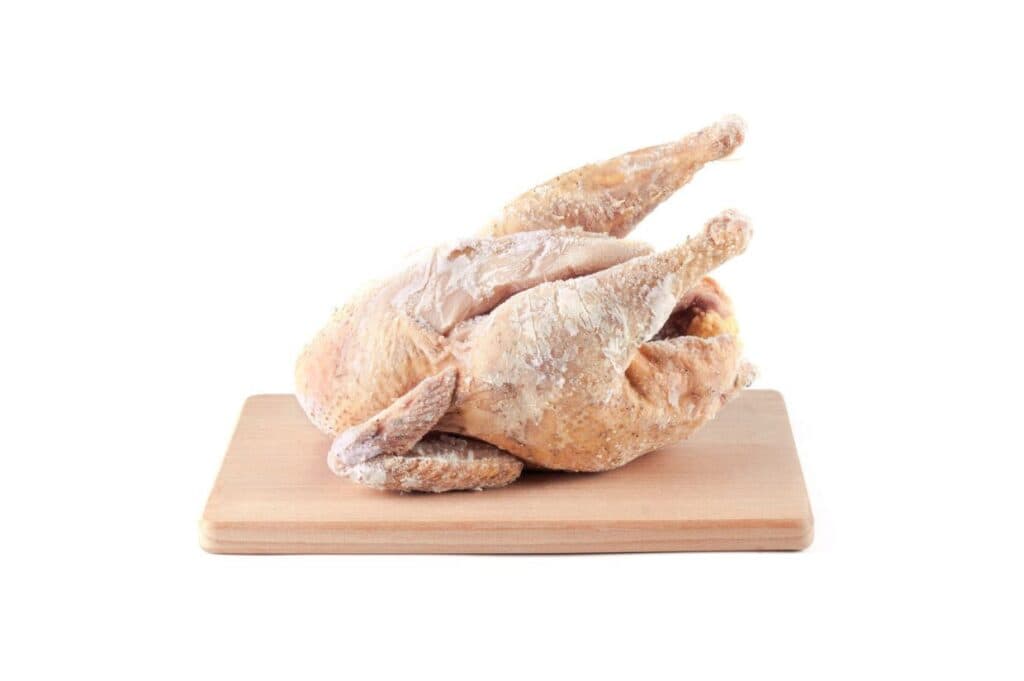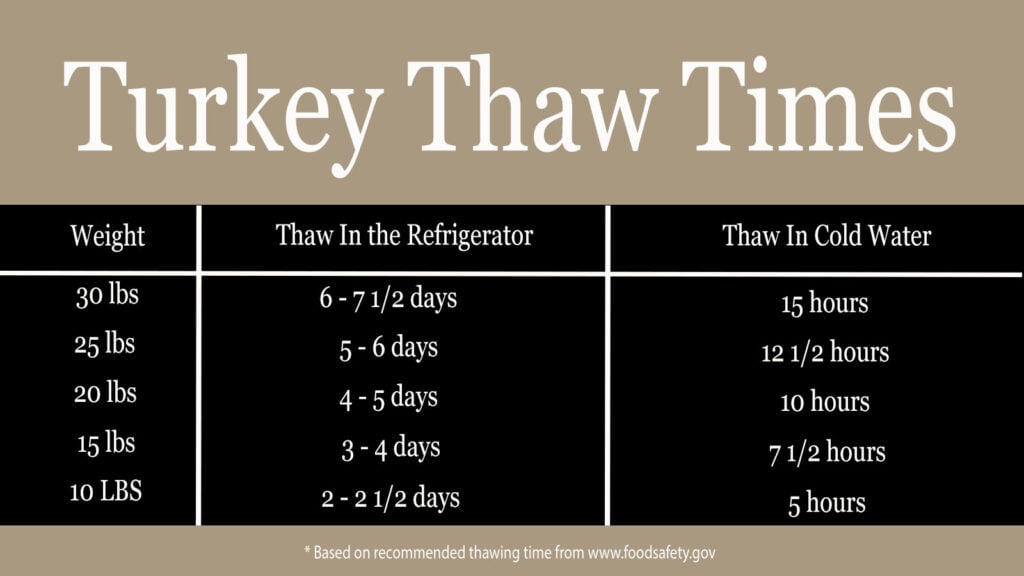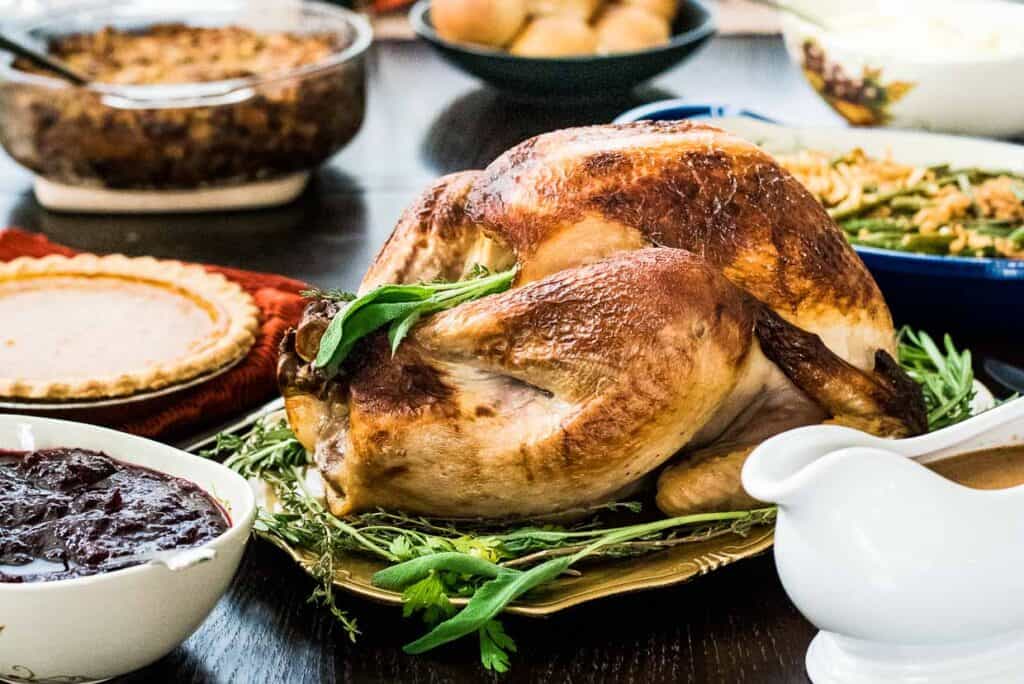Turkey Day is just around the corner, and if you are like most Americans, you’ve already got a bird in your freezer just waiting to make its delicious debut. While you may have picked out the perfect recipe to cook your bird, have you made a plan for how to thaw it? If not, we’ve got you covered with three safe methods and practical tips for making your Thanksgiving turkey oven ready.

Why proper thawing matters
When gathering with family and friends to celebrate all the things you are grateful for in your life, the one thing nobody wants brought to the table is food poisoning. Also on that list is a turkey that just didn’t turn out the way you planned. Unfortunately, an improperly thawed turkey is a prime candidate for a bacterial bonanza that can become a culinary catastrophe.
Food safety should always be the most essential thing to consider when handling raw poultry. Your goal is to keep your turkey out of the danger zone of 40 F to 140 F as much as possible to prevent bacterial growth. Additionally, you must maintain clean surfaces by disinfecting everything that comes into contact with the raw meat or juices and washing your hands often.
Outside of food safety, how you thaw your turkey can have a considerable impact on the meat’s texture. Uneven thawing can leave you with a bird that has perfectly crispy skin and an icy core. Thawing the turkey too quickly can make your turkey tough and chewy instead of tender and juicy. Nobody wants to eat tough turkey.
So, how do you safely and efficiently thaw your bird so you can present the most delectably delicious Thanksgiving centerpiece? Use one of these USDA-approved methods for thawing a turkey: The refrigerator, cold water or the microwave.
Refrigerator thawing
Hands down, the best way to thaw a turkey is in the refrigerator. Moving the turkey from the freezer’s bitter cold 0 F environment into a fridge set between 37 F and 39 F keeps the turkey out of the danger zone and allows it to break out of its icy shell at its own pace. The ice crystals slowly dissolve, leaving you with tender turkey meat that will cook up beautifully.
The biggest drawbacks of this method are the time and space required to get the job done. You can’t just plop your frozen turkey on the top rack of your fridge between the fresh cranberries and the oven-ready overnight breakfast casserole you plan to bake on Thanksgiving morning. As it thaws, it would create a gross mess of raw turkey juices that may just drip down and get on everything.
Instead, you must place it in a large container to hold the juices while isolating the turkey from everything else in your fridge. I find that my turkey roasting pan works great for this job. Give it a spot on the bottom shelf where it’s the coldest, and let it rest.
This method requires 24 hours in the fridge for every 4-5 pounds of turkey. Considering an average Thanksgiving turkey weighs 12-14 pounds, it will take between two and a half to three and a half days for your turkey to thaw. This means moving your turkey to the fridge no later than Sunday night if you plan to cook it on Thursday morning.
As this method is the only one that doesn’t require you to cook the turkey immediately, you may want to consider starting the thawing process on Saturday to be on the safe side. If you plan on using a wet brine like this herbed buttermilk turkey, you’ll want to start thawing on Friday.

Cold water thawing
If you find yourself reading this article on the Tuesday before Thanksgiving, you’ve already realized you don’t have time for a low and slow refrigerator thaw. Instead, the best method for you will be a cold water bath. Instead of taking days to thaw, the cold water method will thaw a 12-14 pound turkey in six to seven hours, or 30 minutes per pound of turkey.
While this method does not require you to dedicate fridge space to your turkey, it does require you to change the water every 30 minutes and cook the bird as soon as it’s thawed. You cannot stick it back in the fridge overnight and use it tomorrow. If you plan to eat at 4 p.m., you want to start this process between 4 a.m. and 6 a.m. to have time for thawing, seasoning, roasting and resting.
This method works because the water transfers the relative heat more efficiently than air while keeping the turkey at a safe temperature. Think about reaching your hand into the freezer to grab a bag of frozen strawberries. Now, imagine plunging your hand into an ice-filled cooler to get a cold drink from the bottom. While the freezer temperature is colder, grabbing that drink from the ice is more painful. This efficient heat transfer allows the turkey to thaw much faster in water than in the fridge.
Since we are trying to get the turkey from 0 F to around 39 F, the water must be cold and the turkey must be completely submerged. Keep it wrapped in its original packaging while it thaws to prevent the meat from getting waterlogged. If you have a large sink that you can dedicate to the task, it will make quick work of regularly draining away the old water and adding fresh. If a sink isn’t an option, a cooler with a dispenser tap also works well. Regardless of what you use, be sure to properly disinfect it afterward.
Microwave thawing
Yes, you read that correctly. You can safely thaw a turkey in your microwave — if it fits. You will need to check your microwave’s owner’s manual for the specific details of which settings to use and how long it will take. If you no longer have the manual, you should be able to look it up online using the make and model of your microwave.
The first thing to do when opting for this thawing method is to ensure your turkey is small enough to fit in the microwave with room to rotate it and flip it over. If it fits, clean your microwave of anything that may come in contact with the turkey. Remove all packaging from the turkey, including metal clips and pop-up timers, and then get to work following the defrosting instructions in the owner’s manual.
As you flip and rotate the bird, check for hot spots or areas that may have started to cook. If you find them, pause the defrosting process and let the turkey rest for five minutes or so for those hot spots to cool back down. Like the cold water method, a turkey defrosted in the microwave must be cooked immediately after thawing.

How to thaw a turkey
Thawing a turkey is an essential first step in turning a solidly frozen turkey into a delicious Thanksgiving meal. Do not leave it on the countertop, don’t set it outside on the back porch or leave it in the trunk of your car. There are simply too many variables outside of your control in those environments. When it comes to food safety, the only three options are in the refrigerator, cold water or the microwave.
Renee N. Gardner is the creative mastermind behind Renee Nicole’s Kitchen, a recipe blog based on seasonal ingredients, dedicated to helping home cooks build their kitchen confidence to become home chefs. When Renee isn’t writing, developing recipes or photographing food, you’ll find her in the garden, traveling or enjoying the outdoors with her husband, son and two dogs.